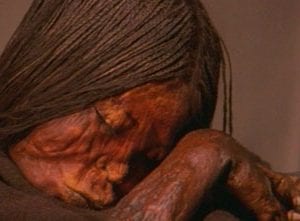Shocking child deaths were all over the news last week. A 6 year-old in Collinsville, Illinois dropped dead on the playground from a brain aneurism, a California mother whose four children died in an apartment fire was found guilty of involuntary manslaughter and a fifth grader in the tiny Midwest town of Ridge Farm that had been bullied at school commit suicide.

One of the most famous Incan child sacrifice victims was a 10 year-old girl named Tanta Carhua, described by one conquistador as, “beautiful beyond exaggeration.”
Her death “devastated” the community, said one Ridge Farm resident.
In our culture, the death of a child is often even more devastating than the death of an adult, but across history and across cultures that has not always been the case. In fact, some cultures take particular pride in killing children. Like the Inca’s, who ritually sacrificed children in an elaborate mountaintop ceremony known as capacocha.
Other Great Reads: A flash flood reveals the secret world of Amish funerals
Children sacrifices celebrated key events, such as the death of an emperor, the birth of a royal son, a great war victory or an important holiday. Sometimes, sacrifices were conducted to prevent droughts and earthquakes, or epidemics. The protocol for capacocha was very particular. First, tribute payment would be collected from the provinces in the form of gold, silver, shells, cloth, feathers, llamas and alpacas. A boy or girl would be rounded up, kids between the ages of 4 and 10 and in prime physical condition. One of the most famous victims was a 10 year-old girl named Tanta Carhua, described by one conquistador as, “beautiful beyond exaggeration.” Often, the child sacrificed was the son or daughter of a chief, as it was thought that sacrificing one’s own children reinforced the tie between the chief and the emperor.
There would be a procession, beginning in the child’s home village and continuing on to Cuzco, the crown seat of the Inca empire. Family members, priests and local chiefs would accompany the child on the journey. In Cuzco, the young victim would have the honor of actually meeting the emperor and there would be huge feasts. Priests would then lead the procession to the designated mountain. A camp would be established at the base of the mountain where llamas, carrying 80-pound loads of soil, grass, and stones, would be corralled. Stone structures were built to offer shelter to the priests and the child. On the summit, the sacrificial platform would be constructed, consisting of a platform made of stone with a large tomb-like interior. Here, the child would be placed, along with burial artifacts like llama carvings, gold and silver statues and ceremonial pots.
After Tanta was taken to Cuzco to meet the emperor she was taken in a procession that passed back through her home village. “You can finish with me now, because I could not be more honored than by the feasts which they celebrated for me in Cuzco,” she reportedly told her fellow villagers. She was then led to her sacrificial platform, high in the Andes and placed alive in the stone tomb. Tanta and other sacrifice victims were given a maize alcohol called chichi, which eased the pain of the cold and altitude. Some researchers believe the children were killed violently, either through suffocation, or a powerful blow to the head. The archeologist Johan Reinhard discovered a famous mummy called Juanita whose skull was indeed fractured, but he believes it resulted from a quick and painless knock specifically intended to spare the children a long and grueling death from exposure.
Other Great Reads: How to deal with the death of a child
Some startling evidence turned up recently that suggests even more preparation went into the sacrifices than previously thought. A 2007 study from the Proceedings of the National Academy of Sciences reported that sacrificial children were actually “fattened up” for the kill in the months before their deaths with high-protein diets. Typically, peasant children ate mostly potatoes, a diet low in protein that resulted in minimal hair growth. But the Inca elites had protein-rich diets, eating foods like maize and llama meat, and hair growth was greater. The study found that in the year before a sacrificial child was killed their hair growth increased tremendously. “It is chilling,” said Andrew Wilson, the head of the study, in a National Geographic News article. “The children, through their own tissue, give us graphic details and evidence that they were not killed on a whim, but were part of a complex process for which they were selected some considerable time before.”
Think the Incas are horrible people for practicing capacocha? Know some stories that are even stranger? Leave a comment below..










Coleen
I feel their culture would be good if it did not include this kind of murder. I don’t care if they say this is religion. This is barbaric! Primitive people who believe in death. There are a lot of cultures before the Incas who practice murdering children. The human race is a sick race. Maybe that is why so far we cannot find human life on any other planet. Would God make the same mistake twice? These Inca children were robbed of their life. God wanted us to be born not be murdered in his name. The Spanish were barbaric too in their own way but I am glad they stopped this child murder. Also, Aztecs would extract the heart of an adult. Then eat the flesh. This is so sick. Apes are better than humans. In Europe a little further back there were sacrifices too. The Vikings were horrors too. Human race is a bad sick race of people. The Inca also was having sex with the Acllas. Many wives. He reminds me of Warren Jeffs of the Morman religion. Sick, sick, sick!